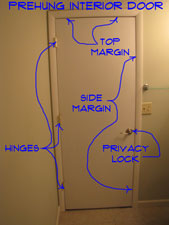 Doors that do not close properly often can be fixed with some adjustment to the door. Before you can adjust a door, you need to understand how the door is supported.
Doors that do not close properly often can be fixed with some adjustment to the door. Before you can adjust a door, you need to understand how the door is supported.
If this is not your problem, see 'Door Repair' for all of the Door Repair topics.
Door Supports
Most doors are supported by two to four hinges, with two or three being typical in most residential homes. An exterior door will likely have three hinges.
Your front door is probably the heaviest door you have. So, if you front door has three hinges and it weighs 100 lbs, you might assume that each hinge supports 33 lbs.
That is not entirely true. The reason is that the door is a rectangular object and it is being supported from one side. Therefore, the force on the hinges is not equal.
In fact, the bottom hinge acts as a pivot point for the weight that is pulling against the top hinge. It is the loosening of the top hinge that causes doors to sag and rub against the frame.
Door Alignment
A properly aligned or adjusted door will have an even margin between the door and the frame all the way around. When the margins are uneven, the door is out of adjustment.
It may not be sticking yet, but it will soon. The wider margins will be on the top of the door on the strike side, and along the side near the bottom on the strike side.
You will also likely have a wider margin on the hinge side near the top of the door.
Adjusting a Door
Adjusting a sagging door properly, will mean tightening the top hinge. Most door manufacturers now require one or two long screws installed through the frame and into the door jambs.
See the articles 'Adjusting Interior Doors' for instructions on your inside doors and 'Adjusting Exterior Doors' for information on adjusting entrance doors.

